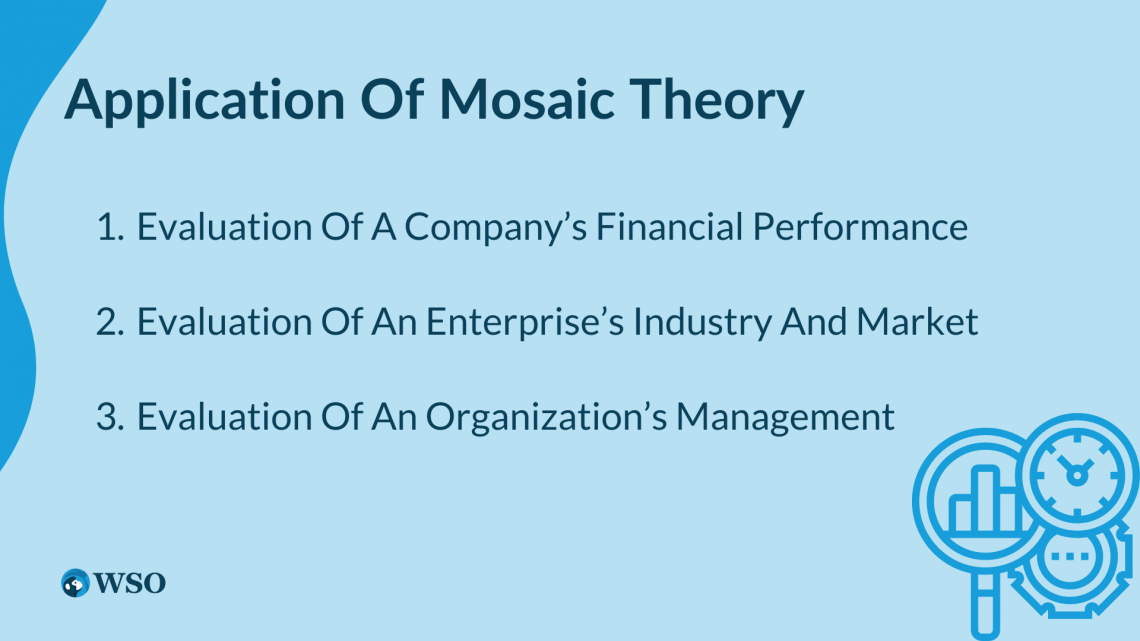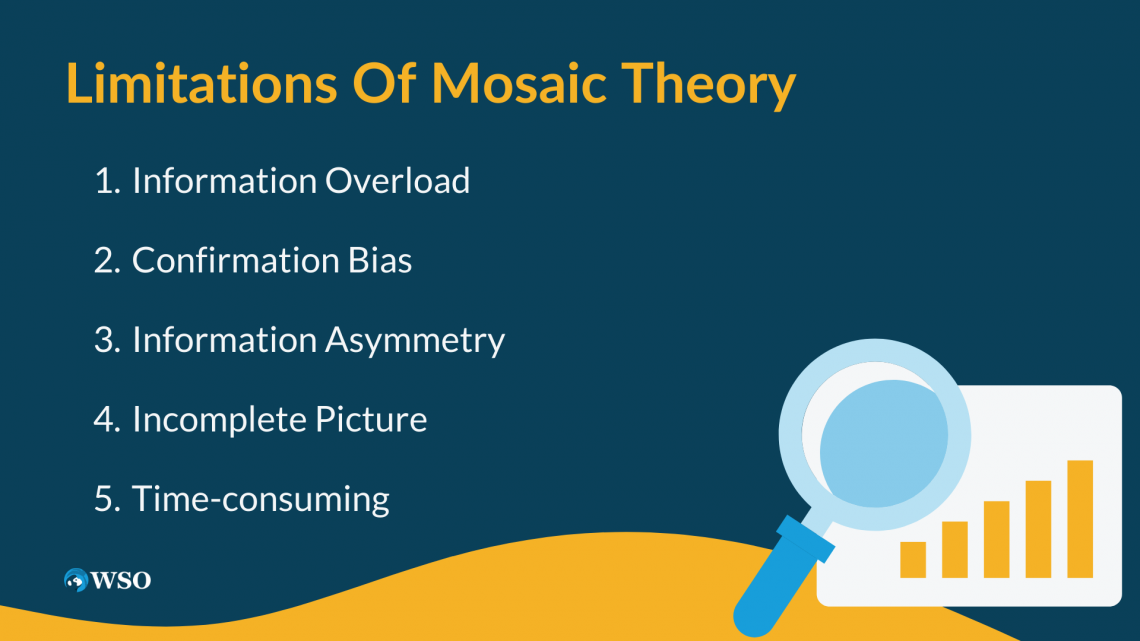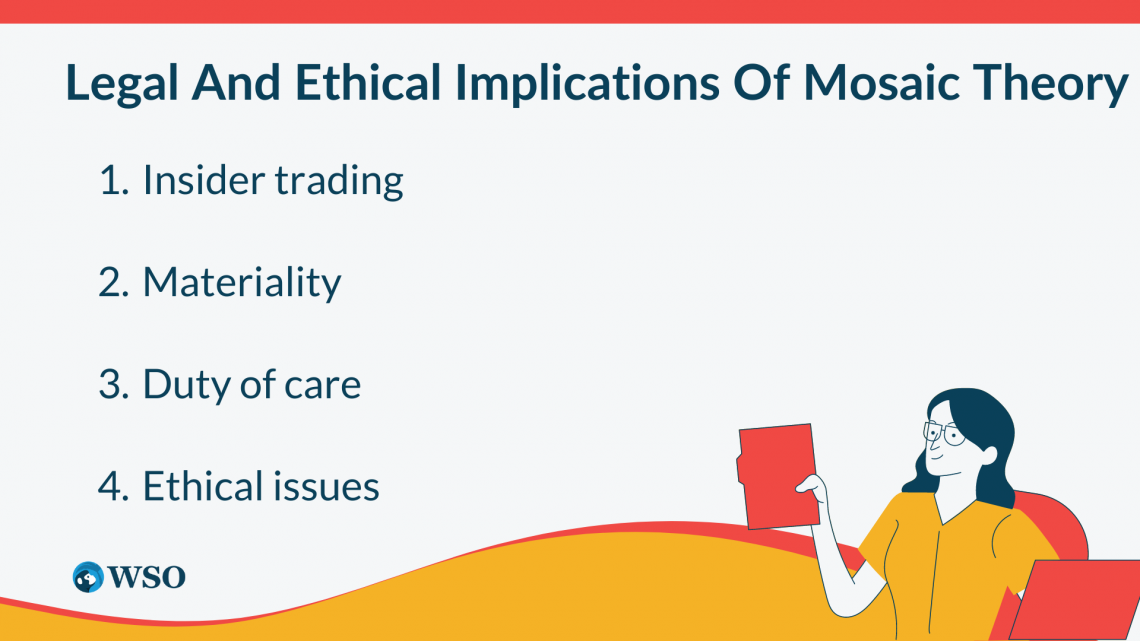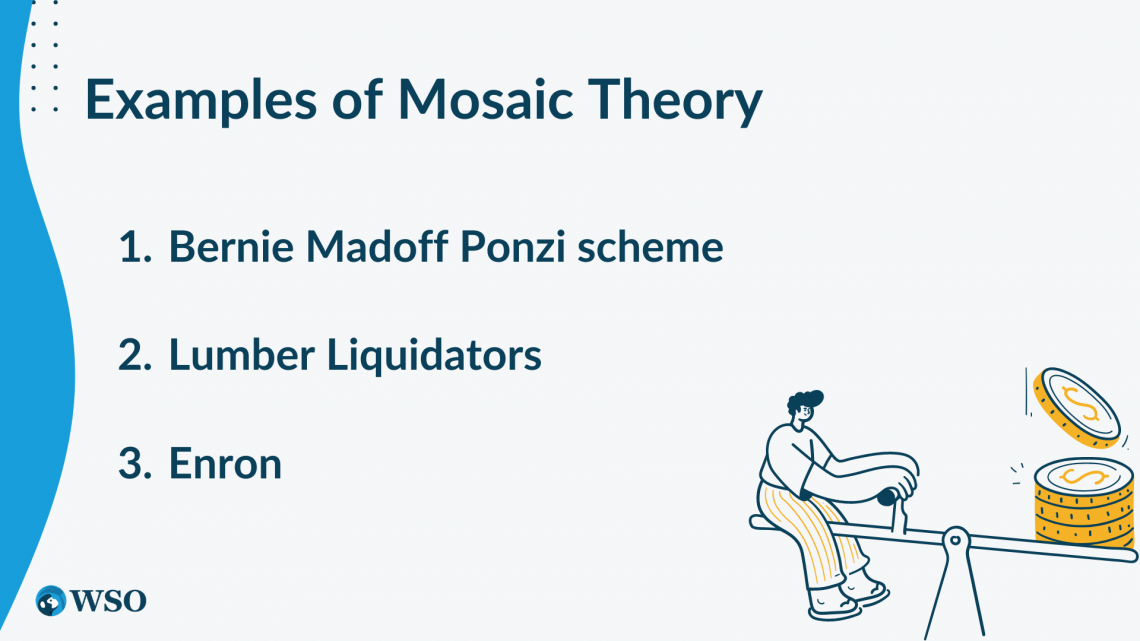Mosaic Theory
It is a powerful tool for investment evaluation, prison interpretation, and ethical selection-making.
What is Mosaic Theory?
The Mosaic Theory has long been a staple within the realm of conducting investment analysis, assisting analysts in obtaining complete knowledge of an enterprise by piecing together facts from a multitude of sources about the organization.

It requires analysts to gather, analyze, and succinctly make a feel of such information about an organization. With so much information, often it can become a challenge to filter out which data is most relevant and the structure to shape a coherent image.
Tackling this challenge calls for the ability to split noise from signs and discover traits and patterns.
The amount of information available in this day and age has exponentially increased to where it is now known as the era of “mass information.” It consists of traditional sources such as financial statements, news articles, journals, and newer resources such as social media, client behavior information, etc.

This influx of information has also created new possibilities for the Mosaic Theory. With greater information available, analysts can become aware of trends and patterns previously hidden or tough to locate.
Mass information can lead to more accurate predictions in identifying future opportunities or assessing and mitigating risks/threats.
Another opportunity offered through massive records is the potential to apply machine studying and artificial intelligence to automate parts of the Mosaic Theory technique.

AI can greatly facilitate chunking and summarizing mass data, allowing analysts to focus more on attention to detail and evaluation. More does not necessarily translate to better.
The sheer amount of records available may be overwhelming, and there is a chance of relying too closely on information-driven analysis for the cost of qualitative research and enterprise expertise.
There is also a risk of bias within secondary forms of information, like customer consumer behavior and social media analytics. Large statistical data presents both opportunities and challenges for the Mosaic Theory.
As analysts continue to grapple with the increasing amount of facts available, they need to strive for stability to apply it professionally and ethically.
Key Takeaways
- The Mosaic Theory is a powerful tool for investment evaluation, prison interpretation, and ethical selection-making.
- This theory additionally has its limitations and capability pitfalls. Analysts have to be careful to avoid confirmation bias and different cognitive biases, which could lead them to attract incorrect conclusions.
- The theory’s capability to synthesize information provides a greater whole picture of corporations and industries.
History of Mosaic Theory
Its history can be traced back to the early days of funding evaluation in the United States.

In the 1930s and 1940s, Benjamin Graham, known as the Father of Value of Investing, and his protege, David Dodd, developed a price investing approach that targeted studying a corporation's financial statements and other publicly available information to determine a company’s intrinsic value.
However, this technique had its limitations, as it did not consider non-financial factors that could impact a company's performance.
In the 1960s and 1970s, new buyer technology emerged, including Warren Buffett and Peter Lynch, who sought to extend the scope of funding analysis past just gauging a company's financials.
These buyers recognized that a company's achievement or failure was determined by monitoring financial performance and additional factors such as enterprise tendencies, management qualities, and customer behavior.

The case concerned a lawyer who purchased stock in an organization that was going to be acquired by one of his regulation firm's customers.
The attorney learned about the upcoming acquisition via exclusive facts received through his work, which he used to buy the stock and make a sizable income.
The Supreme Court, in the end, charged the lawyer responsible for insider trading. That case raised essential questions about using private information in funding evaluation.
In its selection, the Court acknowledged that:
"An analyst who makes a series of sensible guesses about corporate developments isn't thereby undertaking fraud" and that "the analyst's judgments are [not] based on a single, isolated truth, but on a mixture of records and inferences regarding the company and its business."
This laid the basis for the Mosaic Theory, which remains an essential tool to gain knowledge of an agency or industry.
Application Of Mosaic Theory
Some of the applications of the Theory include:

1. Evaluation Of A Company’s Financial Performance
A company’s financial performance is a key metric to comprise the due diligence for a Mosaic Theory.
The numbers do not lie and are a standard and rather a critical component to gauge when analyzing the health of a company.
2. Evaluation Of An Enterprise’s Industry And Market
Analysts can gain insights into the challenges and possibilities of dealing with a business enterprise by analyzing trends inside the industry and market, as well as the competitive landscape and regulatory environment.
Note
These statistics can then be blended with other sources, such as consumer behavior data and social media analytics, to shape the bigger picture of a company’s operations and potential.
3. Evaluation Of An Organization’s Management
Another critical application of this theory is inside the evaluation of an organization's management team.
By tracking an agency's management data, analysts can gain insights into a team's capability to execute an organization's vision and values.
Note
By piecing together statistics from multiple sources, analysts can benefit from insights into an organization's overall monetary performance, industry and market trends, and control group and use these statistics to make informed funding selections.
Limitations Of Mosaic Theory
While an effective tool for funding analysis, it has its limitations. Here are some of the important barriers that limit this theory:

1. Information Overload
One of the largest demanding situations with the Mosaic Theory is that there are copious amounts of records to sift through.
Analysts can become overwhelmed having to go through the sheer volume of available statistics.
2. Confirmation Bias
Another assignment with the Mosaic Theory is that analysts may also fall prey to affirmation bias, when upon discovering information, their existing ideals and biases may close their eyes to rationale and actuality.
3. Information Asymmetry
It assumes that every applicable information is publicly available; however, this isn't always continually the case.
Note
In a few instances, some individuals have insider information (or privileged information) that gains them an unfair advantage over their competitors and the market.
4. Incomplete Picture
Even with exceptional efforts to piece statistics from multiple assets collectively, analysts may nevertheless create an incomplete photo of an enterprise or industry.
Note
There can be hidden risks or possibilities that may not be assessed in the to-be-had facts, so it can be difficult to account for the unknowns.
5. Time-consuming
Compiling a Mosaic Theory requires thorough due diligence, meaning time and resources spent to collect a collective assessment from the various information available. Sometimes paralysis by analysis can kick in, a phrase used when too many technicals and details cause prolonged delays in making informed decisions.
Legal And Ethical Implications Of Mosaic Theory
In addition to its application in conducting investment analysis, the Mosaic Theory additionally has important applications in the realm of detecting fraudulent and unethical activities.:

Perhaps the most controversial topic that the Mosaic Theory can aid with is insider trading. Often a very dangerous accusation requiring hefty evidence, insider trading occurs under the radar when someone with private information not known to the market utilizes it for their advantage.
2. Materiality
Material information is statistics that a reasonable investor would consider critical in making an investment selection. It indicates that fabric statistics may be pieced together from multiple resources.
3. Duty of Care
Funding experts must act in the pleasant pastimes of their customers.
Note
The concept indicates that investment professionals must apply all statistics to make informed investment choices on behalf of their customers.
4. Ethical Issues
The usage, or rather the data misuse, can often have severe implications. It can mean the difference between a felon charge or heft imprisonment. Analysts must utilize information or even sensitive information with the utmost care, integrity, and honor.
Note
While the concept can be an effective device for gaining insights into agencies and industries, analysts have to be privy to the criminal and moral limitations of the theory and use it in an accountable and ethical manner.
Examples of Mosaic Theory
This may be the most interesting part of the article. The Mosaic Theory has been used in real-life examples to take down mega corporations and expose fraudulent activities. Some of these events have been marked in history, too, and are pretty well known in the finance industry.

1. Bernie Madoff's Ponzi scheme
In 2008, a crew of analysts at hedge fund “Aksia LLC” utilized the principles of it to garner evidence of Bernie Madoff's Ponzi scheme.
The analysts pieced together publicly available records from numerous resources, including Madoff's financial statements and trading hobby, to infer that his returns have been impossible to obtain legitimately.
This led Aksia LLC to suggest its clients avoid Madoff's budget and ultimately play a crucial position in exposing the fraud.
This Ponzi scheme concluded when Madoff confessed to his sons in December 2008 that the investment operation was a fraud, leading to his arrest. This scheme is considered one of the largest money frauds in history.
In 2015, quick-supplier Whitney Tilson used the same theory to find evidence that Lumber Liquidators promote laminated floors containing high stages of formaldehyde, a recognized carcinogen.
Tilson pieced together data from several assets, consisting of whistleblower reports, laboratory examinations, and patron complaints, to build a case against the organization. In the long run, this led to a steep drop in Lumber Liquidators' stock price and a settlement with the Consumer Product Safety Commission.

Lumber Liquidators reached a settlement of $26 million with the Consumer Product Safety Commission in 2016 over the allegations of selling laminate flooring containing high levels of formaldehyde. This significantly impacted the company's reputation and led to a sharp decline in its stock price.
3. Enron
The disintegration of Enron in 2001 is perhaps the most famous instance of the Mosaic Theory being used to find company fraud.
Analysts and newshounds gathered data from various assets, including Enron's monetary statements, insider trading activity, and whistleblower reviews, to find proof of accounting fraud and other wrongdoing.
Enron filed for bankruptcy in December 2001 after the revelation of accounting fraud and financial mismanagement, leading to the collapse of the company and subsequent criminal charges against several executives involved in the scandal.
Note
It is vital to note that this theory isn't foolproof, and analysts ought to be cautious to avoid confirmation bias and potential pitfalls.
This led to criminal costs against numerous executives and contributed to the passage of the Sarbanes-Oxley Act, which added new guidelines for company accounting and governance.
These examples show the strength of the Mosaic Theory in uncovering precious data about organizations and industries. Analysts can gain insights to make groundbreaking discoveries and aid in well-informed decision-making by piecing together facts from multiple sources.
Mosaic Theory FAQs

It is a funding evaluation technique that involves piecing together records from multiple information banks to gain insights into companies or industries.
Its potential limitations consist of the hazard of confirmation bias, the opportunity of misguided or incomplete facts, and ethical limitations surrounding the usage of personal information.
It can be utilized in criminal and moral decision-making to help analysts piece together information from multiple sources to shape the big picture.
Do note that it is essential to be aware of prison and ethical limitations, especially on the subject of insider buying and selling and the use of private facts.
Skills essential for success when using it are vital curiosity to delve deep, intellectual interest, and the capability to synthesize records from a couple of sources.
Additionally, strong research and evaluation abilities and an understanding of misuse and ethical boundaries are critical for achievement.
It can be applied to any industry or zone, so long as there is enough information to be had from plenty of resources to piece a whole photo collectively.
The following industries/sectors make for really good Mosaic Theory research:
- Healthcare
- Finance Corporations
- Technology and Software
- Renewable Energy
- Consumer Goods and Retail
- Real Estate and Construction
While essential analysis mainly revolves around ratios and financial statements of a company, the Mosaic Theory takes it a step further by including status and information from a range of public and private assets.
Best practices for the usage of it in investment evaluation include:
- Verifying data from more than one resource
- Being aware of cognitive biases that could affect decision-making
- Know-how of the ethical barriers
- Stay up-to-date on emerging traits and technology that could impact the industry or enterprise being analyzed










or Want to Sign up with your social account?